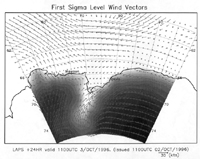


Antarctic Operational Meteorology
Abstract
Introduction
The Past
The Present
The Future
Acknowledgements
References
Index
Search
Help
Contact us

In addition to the automation of observations, the communication and processing of data for assimilation in real time into atmospheric modelling systems and the space and time resolution of such schemes themselves are likely to improve rapidly as computer technology evolution continues with few apparent limitations. In particular, new models designed to analyse and predict conditions for limited local areas are being developed. For example, the Limited Area Prediction System (LAPS) developed in the Bureau of Meteorology Research Centre (Puri et al 1996) is being adapted for high latitude use by the Bureau of Meteorology's Tasmania Antarctica Regional Office and the Antarctic Co-operative Research Centre (CRC) at the University of Tasmania. Figure 23 shows an example of a LAPS forecast developed for a limited area of the AAT.

The human element will not, however, be entirely lost as eventually the products of all automatic equipment have to be interpreted by the experienced scientist and technician who will hopefully continue to remain in control. The days of the explorer plodding across the ice-cap recording meteorological data and dispatching it to the outside world are rapidly becoming a thing of the past; nevertheless even with all the technology a helicopter flying to a remote site will still need "a person on the ground" to provide a visual report on local conditions if full safety is to be preserved.
Meteorological staff will continue to be part of ANARE as they have for the past 50 years. However, they may be fewer and will require to have different training and experience. More effort will be Australia based. It is to be hoped however that the wonder and beauty of Antarctic weather will still be personally experienced by the meteorologists of the future and that the data collected will continue to provide, in their own way, the basis for research studies, for analyses of weather and climate and for operational services to those on the continent and those "outside".
Acknowledgements
The author wishes to express his appreciation to his many colleagues in the Bureau of Meteorology who have assisted in the preparation of this paper in particular Hugh Hutchinson, Steve Pendlebury, Neil Adams and Kieran Jacka in the Tasmania Antarctica Regional Office and to Frank Whitby, Esther Amott, Bernie Stokes and most importantly to Debbie Dowel of the Bureau's Head Office in Melbourne.
 |
Bureau of Meteorology |  |
© Online Edition Australian Science and Technology Heritage Centre and Bureau of Meteorology 2001
Published by Australian Science and Technology Heritage Centre, using the Web Academic Resource Publisher
http://www.austehc.unimelb.edu.au/fam/1593.html